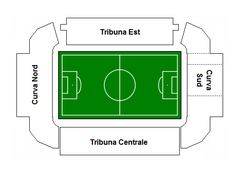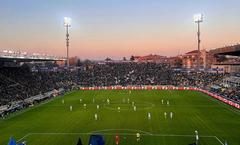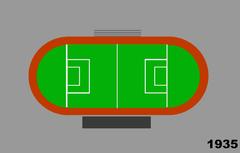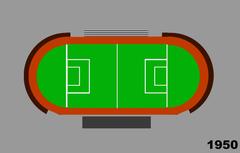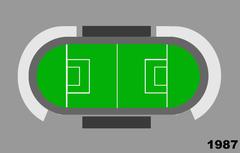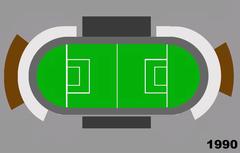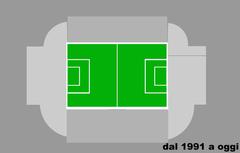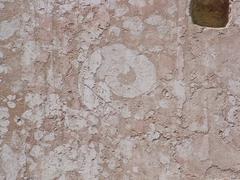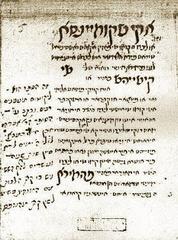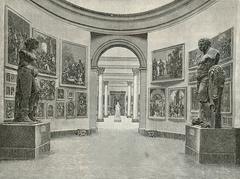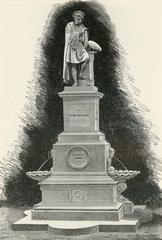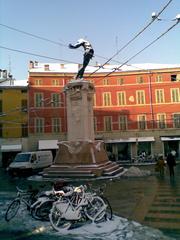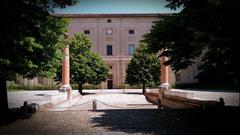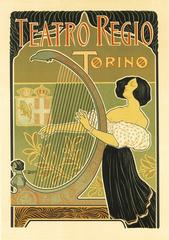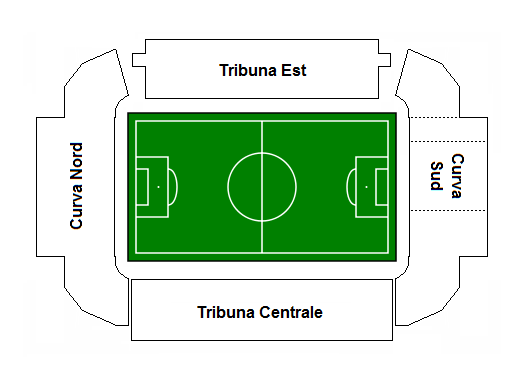
Stadio Ennio Tardini Visiting Hours, Tickets, and Parma Historical Sites Guide
Date: 14/06/2025
Introduction
Stadio Ennio Tardini is a cornerstone of Parma’s sporting and cultural landscape, seamlessly blending nearly a century of football tradition with the city’s vibrant community spirit. Established in 1923 and named after visionary lawyer and Parma Football Club president Ennio Tardini, the stadium stands just one kilometer southeast of Parma’s historic center, making it both a footballing temple and a gateway to the city’s renowned art, architecture, and gastronomy (stadiodiparma.it; parmacalcio1913.com).
From its Art Deco origins to modern upgrades and future redevelopment, the Tardini offers visitors not only thrilling matchday experiences but also access to guided tours, the Ernesto Ceresini Museum, and proximity to major Parma attractions such as the Palazzo della Pilotta, Parma Cathedral, and Teatro Regio (stadiumdb.com; footballtripper.com; stadiumguide.com). This guide provides a detailed overview of the stadium’s history, architecture, visitor essentials, upcoming redevelopment, and travel tips for making the most of your Parma visit.
Table of Contents
- Historical Overview
- Visiting Stadio Ennio Tardini: Essential Information
- Cultural Significance and Community Role
- Matchday Experience and Special Events
- Redevelopment Plans (2025 Onwards)
- Frequently Asked Questions (FAQ)
- Conclusion & Key Takeaways
- References
Historical Overview
Origins and Early Development
Parma’s football journey began in the early 20th century, with makeshift pitches giving way to the need for a permanent home as local enthusiasm surged. Ennio Tardini spearheaded the initiative, rallying community leaders and launching a design competition. Architect Ettore Leoni’s vision integrated Art Deco elegance and multi-sport functionality, including a running track and gymnasium, into the heart of the Castelletto area (stadiodiparma.it; stadiumdb.com).
Construction began in 1922, and after Tardini’s untimely passing, the stadium was named in his honor. The Tardini opened officially in September 1923, hosting a memorable draw between Parma FC and A.C. Milan (factsgem.com; gentlemanultra.com).
Architectural Evolution
- 1920s–1960s: The original circular layout with a running track reflected its multi-sport ambitions. Art Deco and Liberty-style features—especially the monumental main gate—set the stadium apart in the Italian context. Minor upgrades included enhanced athletic facilities and, in the 1960s, expanded seating and floodlights (factsgem.com; parmacalcio1913.com).
- 1980s–1990s: Parma’s promotion to Serie A in 1990 prompted a comprehensive renovation. The oval was replaced with a rectangular plan, stands moved closer to the pitch, and capacity surged to nearly 28,000. The stadium’s modern football-focused design now offered an intense, intimate atmosphere (cultofcalcio.com; parmacalcio1913.com).
- 2000s–Present: Upgrades have prioritized accessibility, comfort, and safety. The East stand was rebuilt and covered, ticket offices relocated, and facilities for disabled fans greatly improved. Current capacity is about 22,000–23,324, making it Parma’s largest sporting venue (stadiodiparma.it; my sportstourist).
Visiting Stadio Ennio Tardini: Essential Information
Visiting Hours and Tickets
- Matchdays: Gates open approximately 90 minutes before kickoff; closing shortly after the match.
- Guided Tours: Available on non-matchdays (usually 10:00 AM–5:00 PM), including access to locker rooms, the Ernesto Ceresini Museum, and key stadium areas. Advance booking via the official Parma Calcio website is recommended.
- Tickets: Purchase online through the official club website or Ticketone, at authorized outlets, or at the stadium box office. Prices start at €15 for Curva seats and rise to €100 for premium Tribuna Petitot sections. Family, senior, youth, and disability discounts are available (stadi.online).
Accessibility
Stadio Ennio Tardini is committed to inclusivity. Renovations have introduced:
- Wheelchair-accessible seating and restrooms.
- Accessible entrances and assistance upon request.
- Discounted tickets for visitors with disabilities over 70% certified (stadiumdb.com).
Getting There and Nearby Attractions
- Location: Viale Partigiani d’Italia, 1, 43123 Parma, just 1 km from the historic center (stadi.online).
- Public Transport: Bus lines 9 and 23 connect the stadium with Parma Centrale station and Barilla Center. The stadium is a 10–15-minute walk from Piazza Garibaldi (my sportstourist).
- Parking: No onsite parking; use public transport or park at designated outer city lots and use shuttle services on matchdays.
Nearby Attractions:
- Palazzo della Pilotta
- Parma Cathedral (Duomo)
- Teatro Regio
All within easy walking distance, enabling visitors to combine sporting excitement with cultural exploration.
Facilities and Amenities
- Seating: Covered and uncovered options, with the Tribuna Petitot offering premium views.
- Museum: The Ernesto Ceresini Museum exhibits Parma Calcio’s trophies, historic kits, and memorabilia (stadi.online).
- Dining: Concession stands serve classic stadium fare. The central location allows for easy access to Parma’s renowned eateries.
- Restrooms: Recently upgraded for comfort and accessibility.
- First Aid: Medical stations are available and signposted.
Cultural Significance and Community Role
The Tardini is deeply woven into Parma’s urban fabric and civic identity. It has been the emotional stage for local derbies, European triumphs, and generational fan traditions. The “Boys Parma 1977” ultras are famed for their passionate displays, and matchdays transform the surrounding neighborhood into a sea of yellow and blue (gentlemanultra.com).
Beyond football, the stadium hosts community gatherings, exhibitions (such as the 2024 centenary at Palazzo del Governatore), and is a focal point for preservation and urban regeneration efforts (stadiumdb.com).
Matchday Experience and Special Events
- Tardini Excellence Experience: A premium package combining guided museum tours, gourmet dining by Michelin-starred chefs, and interactions with Parma legends (parmacalcio1913.com).
- Atmosphere: The stadium’s proximity of stands to the pitch amplifies the noise and energy, offering one of Italy’s most intimate football experiences (footballtripper.com).
- Special Events: Occasional concerts, women’s football, and community initiatives are hosted, though large non-sporting events are rare (stadi.online).
Redevelopment Plans (2025 Onwards)
Vision and Impact
Beginning in 2025, Stadio Ennio Tardini will undergo a transformative redevelopment led by Studio Zoppini Architetti, with a €140 million investment fully funded by Parma Calcio (thestadiumbusiness.com).
Key Features:
- Capacity: About 21,000 seats, prioritizing comfort and accessibility.
- Full Roof Coverage: All stands shielded for improved spectator experience.
- Sustainability: Eco-friendly materials, solar energy, and efficient systems (arcadis).
- Inclusivity: Enhanced facilities for disabled fans and families.
- Community Spaces: Expanded retail, dining, and museum areas. The new Petitot grandstand will feature lounges, skyboxes, and restaurants (theplan.it).
- Preservation: Historic gates and arch retained as ceremonial entrances.
Temporary Relocation: During construction (2025–2027), Parma Calcio will play at an alternate venue, with options including Reggio Emilia, Ferrara, Bologna, or Modena (thestadiumbusiness.com).
Urban Integration: The project addresses concerns over noise, traffic, and neighborhood quality of life, with city oversight ensuring responsible development (stadioparma.it).
Frequently Asked Questions (FAQ)
Q1: What are Stadio Ennio Tardini’s visiting hours?
A: On matchdays, gates open 90 minutes before kickoff. Guided tours are available on non-matchdays (10:00 AM–5:00 PM) by appointment (parmacalcio1913.com).
Q2: How can I buy tickets for matches?
A: Tickets are available online, at authorized outlets, or the stadium box office. Early booking is advised for popular matches (ticketone.it).
Q3: Is the stadium accessible for people with disabilities?
A: Yes, with dedicated seating, accessible entrances, and discounted tickets.
Q4: Are guided tours available?
A: Yes, on non-matchdays. Book via the official website.
Q5: What are the best spots for photography?
A: The Tribuna Petitot for panoramic views, the Liberty-style entrance, and the Ernesto Ceresini Museum.
Q6: What historical sites are nearby?
A: Palazzo della Pilotta, Parma Cathedral, and Teatro Regio.
Conclusion & Key Takeaways
Stadio Ennio Tardini is far more than a football venue; it is a living monument to Parma’s civic pride, sporting history, and cultural vitality. Visitors enjoy not just Serie A excitement but also guided tours, museum experiences, and access to the city’s most celebrated landmarks. With an ambitious redevelopment on the horizon, the Tardini is poised to remain a centerpiece of Parma’s identity for generations to come.
Plan your visit:
- Secure tickets and tours through official channels.
- Explore the Ernesto Ceresini Museum and vibrant matchday atmosphere.
- Combine your stadium visit with walks to Parma’s historic attractions.
- Stay updated via Parma Calcio’s official site and the Audiala app for real-time news and exclusive content.
References
- stadiodiparma.it
- parmacalcio1913.com
- stadiumdb.com
- gentlemanultra.com
- footballtripper.com
- stadiumguide.com
- stadi.online
- thestadiumbusiness.com
- parmacalcio1913.com - Tardini Excellence Experience
